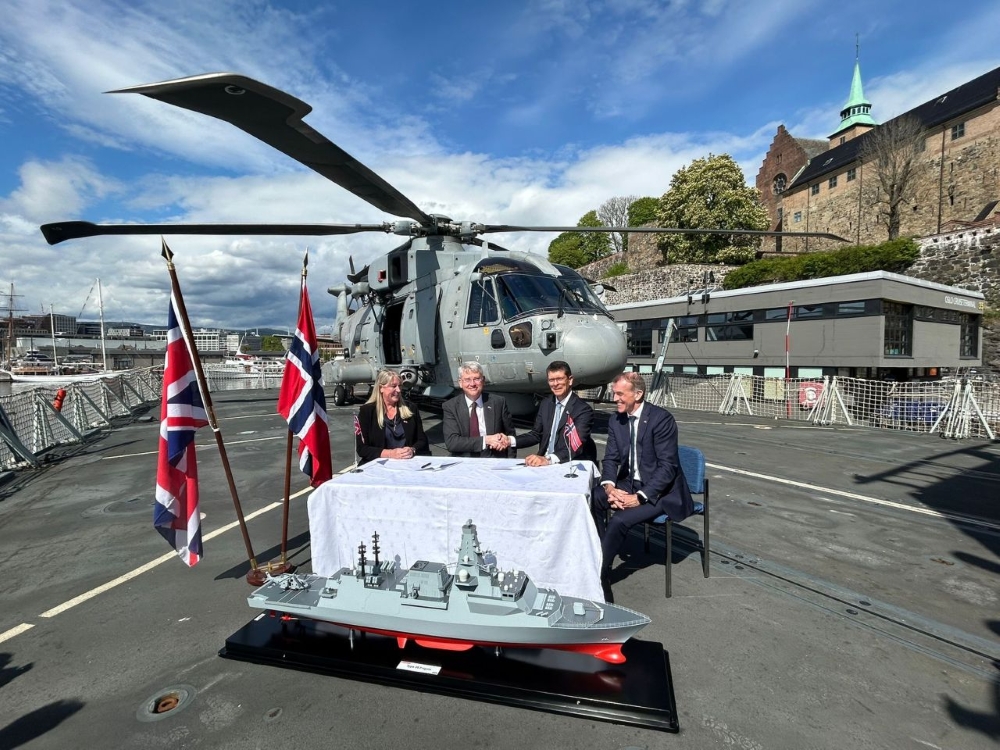
In a press conference at Noon on Sunday 31 August, Norway’s Prime Minister Jonas Gahr Støre has announced the selection of the United Kingdom as the strategic partner for the project for the new frigates.
The Prime Minister noted that the choice was difficult as the finalists all put forward “strong entries” and all remain key strategic partners: the US entered the CONSTELLATION class (itself an evolution of the Italian FREMM ASW design); France its FDI (Frégates de défense et d'intervention) and Germany pushed its prospective F127 MEKO A-400 design.
The requirement was specifically for an anti-submarine frigate and for a key, long-term partnership for operations in the Arctic and North Atlantic and this led to BAE Systems’ Type 26 emerging as the best solution for Norway.
“At least 5” and possibly 6 frigates are to be build, with the first delivery expected in 2030. Norway does not have shipyards truly suitable to a project of this magnitude so the build will happen in Scotland, at the Govan and Scotstoun shipyards, alongside the ships for the Royal Navy. It is indeed widely anticipated that one of the Type 26s already in build will have to change flag to ensure the delivery timeline is met.
In February, however, BAE signed a MoU with HAMEK, which has a yard in Harstad, Northern Norway, which would see their existing dock expanded to handle maintenance of the Type 26. A hundred million NOK will now be spent by BAE to expand the dock and cover it with a hall, turning it into the largest facility of its kind north of Fosen.
Back in May, onboard HMS ST ALBANS, a Royal Navy Type 23 frigate visiting Oslo, BAE Systems and Kongsberg had also already signed a partnership agreement “that could extend to Kongsberg’s Vanguard vessel system (a solution for highly modular capability embarkation on “generalist” hull), a strategic partnership for through-life support for the new Type 26 frigates, strike missiles, maritime surveillance and targeting and ship system deliveries to both nations’ frigates”.
The Royal Navy has indeed already adopted Kongsberg’s Naval Strike Missile as its (interim) replacement for HARPOON, with the “final” solution expected to emerge from the MBDA Future Cruise and Anti-Ship Weapon project.
It will take some time to work out in detail the Government to Government “whole package” for this 10 billion pounds mega deal, the biggest in Norway’s history and one of immense relevance for British industry as well. A wide range of new agreements are expected to maximize returns for Norway firms, from Kongsberg to Umoe Mandal, a specialistic in Composites which already makes all Type 26 composite mainmasts. BAE and Umoe Mandal have also already teamed with the Royal Navy’s Commando Insertion Craft requirement in mind: this new advanced landing craft, intended to replace the LCVP MK5, should progress to contract in the new year.
Other indirect returns for Norway could follow if the UK was to pick the Joint Strike Missile, the air launched evolution of NSM, for its F-35Bs. While this is not currently in the plans, such a stand-off solution would fix some of the limitations of the UK’s Lightning Force.
The Royal Navy is due to buy at least 3 "mothership" vessels for its Mine Hunting Capability (MHC) to replace the HUNT-class vessels in out of area operations in the next few years and the already mentioned Kongsberg VANGUARD system must now more than ever be considered a frontrunner. It is fair to assume the ships could end up being the same Norway eventually picks for its own program for new Large multi-role vessels.
Norway specifies that it wants its Type 26s to be more or less identical to Royal Navy's ones, to enable possible joint crewing arrangements, creating almost a shared fleet for the security of the North Atlantic. This, in turn, would seem to considerably increase the chances of the Leonardo AW101 MERLIN to be selected for their ASW helicopter requirement.
The development of the new Mod2 STINGRAY torpedo by BAE Systems should also benefit. Already picked by Germany in the bilateral agreements with London with use on the P-8 POSEIDON in mind, it now should have an advantage in Norway as well.
The planned development of a Vertical Launch, rocket-boosted Mod2 for use on Type 26 would appear to be even further favoured by this development, for obvious reasons. Norway’s Nammo might be able to provide the rocket motor.
Norway’s PM and Defence Chief in the conference also mentioned that development of uncrewed solutions is also looked at with interest. There is enormous scope for cooperation not just on the Type 26, their crewing and their operations in the North Sea, but on a number of "accessory" systems around them, in other words.
It’s worth remembering that Norway is also due to decide between MQ-4C TRITON and MQ-9B (PROTECTOR in RAF service) for its long range ISR drone project. Selection of the latter would further reinforce cooperation and integration.
The selection of a Type 26 “identical to the Royal Navy’s” also implies good news for MBDA UK on the CAMM/SEA CEPTOR front and, longer term, probably on the Future Cruise Anti-Ship Weapon as well, as this is supposed to arm Type 26 against ships and targets deep inland.
In turn, there might be interesting discussion to be had on maybe expanding the Type 26’s capability in the AAW role. Unlike the Royal Navy, Norway does not have AAW destroyers, so might be interested in migrating SM-2 (and beyond, in time) onto the Type 26's MK41 cells, in turn driving radar evolution.
We might know more about these other cooperation opportunities in the near future as a renewed UK-Norway defence agreement is in the works.
The Type 26 for Norway as showcased in model form by BAE Systems is indeed mostly identical to the Royal Navy one but with the addition of a massive battery of 16 NSM missiles atop the hangar.
Overall, it is estimated that 4,000 UK jobs, including more than 2,000 in Scotland, will be supported by this deal, which will benefit more than 400 different companies.
Follow us on Telegram, Facebook and X








.png)
